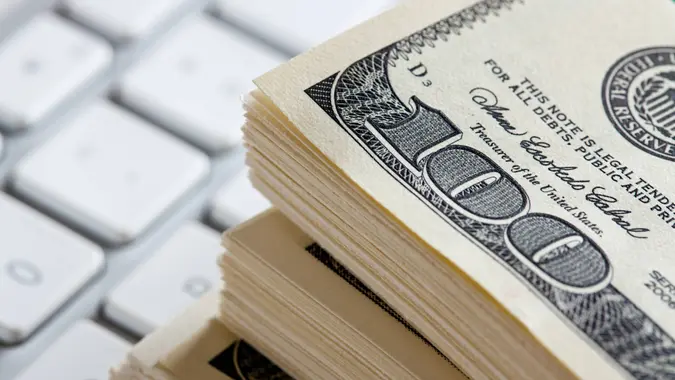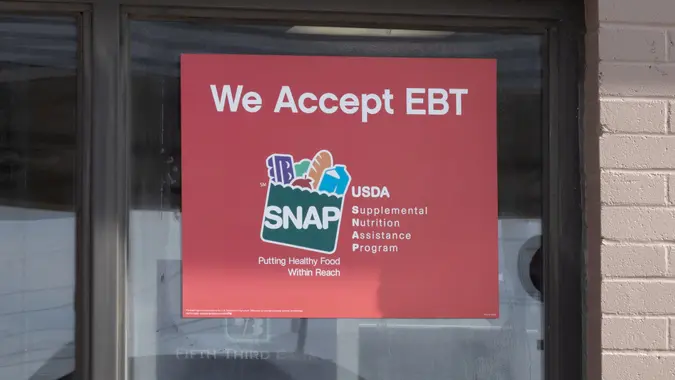3 Ways an Emergency Fed Rate Cut Could Help Consumers

Commitment to Our Readers
GOBankingRates' editorial team is committed to bringing you unbiased reviews and information. We use data-driven methodologies to evaluate financial products and services - our reviews and ratings are not influenced by advertisers. You can read more about our editorial guidelines and our products and services review methodology.

20 Years
Helping You Live Richer

Reviewed
by Experts

Trusted by
Millions of Readers
Earlier this month, markets took a tumble, which, coupled with a weak jobs report, sparked concerns about a looming recession. In turn, many experts called for a so-called “emergency” federal funds rate cut to try to prevent it and to prevent consumer wallets from taking a hit.
An emergency rate cut is when the Federal Open Market Committee cuts the federal funds rate on an unscheduled basis rather than wait until one of its regularly scheduled meetings, explained Jeffrey A. Rosenkranz, portfolio manager, Shelton Capital Management.
Talk about such an emergency cut since has been scaled back, especially as the next FOMC meeting is mere weeks away — Sept.17 and 18. More importantly, consumer inflation dropped to 2.9% in July. While still a bit off the Fed’s 2% target, the decrease cements a September rate cut, with the CME FedWatch Tool placing the odds at 100% as of Aug. 21.
That said, here are three ways an emergency federal funds cut could help consumers if the Fed were to implement one.
1. Reduce Interest Rates
As Realtor.com chief economist Danielle Hale explained, rate cuts, whether they happen at a scheduled meeting or at an unscheduled meeting, lower the federal funds rate, an overnight lending rate for banks that is set by the Fed.
“This short-term rate influences other rates on everything from car loans to credit cards to mortgages, but it’s not always a one-for-one correlation,” she said.
Fed rate cuts impact borrowing rates tied to indexes such as home equity lines of credit or adjustable-rate mortgages fairly quickly — and these borrowers may see their rates drop, she added.
In addition, an emergency rate cut can reduce loan and mortgage fixed interest rates, making borrowing more affordable for consumers, said Dutch Mendenhall, co-founder, RADD Companies.
This is something that was echoed by Hale, who noted that before the Fed’s emergency actions in March 2020, mortgage rates had hovered in the 3.5% range.
“Within the next six months, the typical 30-year fixed mortgage rate had fallen under 3%,” said Hale.
2. Support Job Creation
According to Mendenhall, an emergency rate cut could also help consumers by producing benefits for the economy.
“This can boost consumer spending and investment, potentially supporting job creation and economic growth during downturns,” he said.
As he further argued, an emergency rate cut makes borrowing cheaper for businesses, so they’re more likely to expand and hire.
“This pumps more money into the economy and ramps up demand, which means more jobs for everyone,” he said.
However, those new jobs could take time to materialize. Mendenhall noted that during the 2008 financial crisis, rapid rate cuts helped stabilize markets but didn’t immediately revive economic growth. Similarly, the 2020 cuts, aimed at counteracting the impact of COVID-19, supported a swift but uneven recovery.
3. Protect Wealth
According to Rosenkranz, an emergency cut would provide little immediate relief for consumers but would, in such a circumstance, “help avoid the wealth destruction that would come with a big correction in stocks or the housing market.”
As he explained, given that much of the consumer spending and positive sentiment recently have been driven by significant wealth accumulation from gains in equities and significant home price appreciation, any drawdown would be severely detrimental to individuals and the economy overall.
What Is an Emergency Rate Cut?
An emergency rate cut is an off-schedule reduction in the federal funds rate. It’s designed to immediately inject liquidity into the financial system, lower borrowing costs and restore consumer and investor confidence toward economic recovery, said Ben Vaske, senior investment strategist, Orion Portfolio Solutions.
When Did the Fed Implement Emergency Rate Cuts and What Were the Implications?
An emergency cut is “an extraordinary remedy and akin to breaking glass in case of emergency,” said Rosenkranz, noting that such cuts are usually reserved for times of systemic stress, where an injection of calm and stability is warranted, or when significant changes in the economic environment justify not waiting for the next scheduled meeting.
“True emergency cuts are rare,” Vaske said, noting that historically, such cuts have had mixed outcomes.
For example, during the 2008 financial crisis, emergency cuts helped stabilize markets but couldn’t prevent a deep recession, he said.
Similarly, the 2020 rate cuts during the COVID-19 pandemic initially calmed markets but were followed by sharp economic contractions, although this recession was short lived for investors, and 2020 inevitably posted above-average market returns, added Vaske.
And while the 2020 cuts also sparked a mortgage rate spike, they ultimately helped lower the rates, Hale said.
Will Luther, director, Sound Money Project at the American Institute for Economic Research, further argued that emergency rate cuts are a double-edged sword.
On the one hand, it helps move the policy rate closer to where the Fed thinks it should be, making tight monetary policy less restrictive, he said.
“On the other hand, it signals to the market that the FOMC has been caught off guard,” added Luther.
Will the Fed Consider an Emergency Rate Cut in the Fall?
Wharton School professor emeritus of finance Jeremy Siegel called for such a cut in early August but since has told CNBC that he no longer thinks it’s necessary.
As Jamie Cox, managing partner, Harris Financial Group, said, the Fed minutes released on Aug. 21 “removed all doubt about a September rate cut.”
Yet opinions vary as to whether serious talks about an emergency rate cut could resurface later this year. For instance, Mendenhall argued that if the Fed doesn’t cut rates “significantly” in September — by more than 25 basis points — expect renewed discussions as the holidays approach.
“The Fed often revisits its policies in response to changing economic conditions and market expectations, so further rate adjustments could be on the horizon,” he said.
On the other hand, Shelton Capital’s Rosenkranz noted that economic data does not suggest the need for such an intra-meeting cut, as the early August volatility has calmed down. He added that if labor market conditions deteriorate more rapidly, the Fed can always increase the size and pace of future cuts without the need for an emergency cut.
However, as is often the case with emergency rate cuts, “the events that would create the need for such a remedy are usually unpredictable and unforeseen,” he said.
More From GOBankingRates
- Nearly 1 in 3 Americans Hit by a Costly Holiday Scam, Norton Survey Shows -- How To Avoid This
- Here's What Retirees Wasted the Most Money On in 2025 -- and How To Avoid It in 2026
- How Middle-Class Earners Are Quietly Becoming Millionaires -- and How You Can, Too
- 6 Safe Accounts Proven to Grow Your Money Up to 13x Faster
 Written by
Written by  Edited by
Edited by 

























